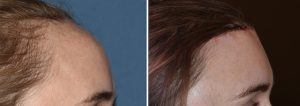The forehead occupies a major part of the face, up to one-third of its total length. It is a major contributor to facial aesthetics even though it appears largely as a blank slate. Because it has few identifiable features (only the eyebrows) other than wrinkles, it is often overlooked as a facial feature which can be modified. Botox and browlifts affect change in the overlying soft tissue, but the bony shape of the forehead
The forehead is outlined by three features which create the visual impression of its overall size. The top of the forehead is marked by the variable position of the frontal hairline which differs greatly by female vs. male gender. The bottom of the forehead is evidenced by the eyebrows and the supraorbital rims, which is the ridge of skull bone just above the eyes. The sides of the forehead are defined by the temporal ridges, the edges of the bony forehead where it meets with the large temporalis muscle.
It is the shape of the bony forehead (amount of convexity) and the prominence of the brow ridges that help define a more masculine or feminine appearance. In times past, its shape was also thought to impart the degree of intellect of an individual. This is most commonly portrayed in movies where the villians, monsters and other evil-doers will usually have big and bulging foreheads, often being grotesquely distorted.


These aesthetics considerations are critical when it comes to performing recontouring of the forehead in men and women. While forehead reshaping is often thought of as exclusively being done in facial feminization surgery, it is not in my experience. I have done as many if not more forehead surgeries in gender-stable patients. It is the nuances of the brow shape and how it flows into the upper forehead in both frontal and profile views that can make the difference between a good vs. an unhappy surgical outcome.
Dr. Barry Eppley
Indianapolis, Indiana


